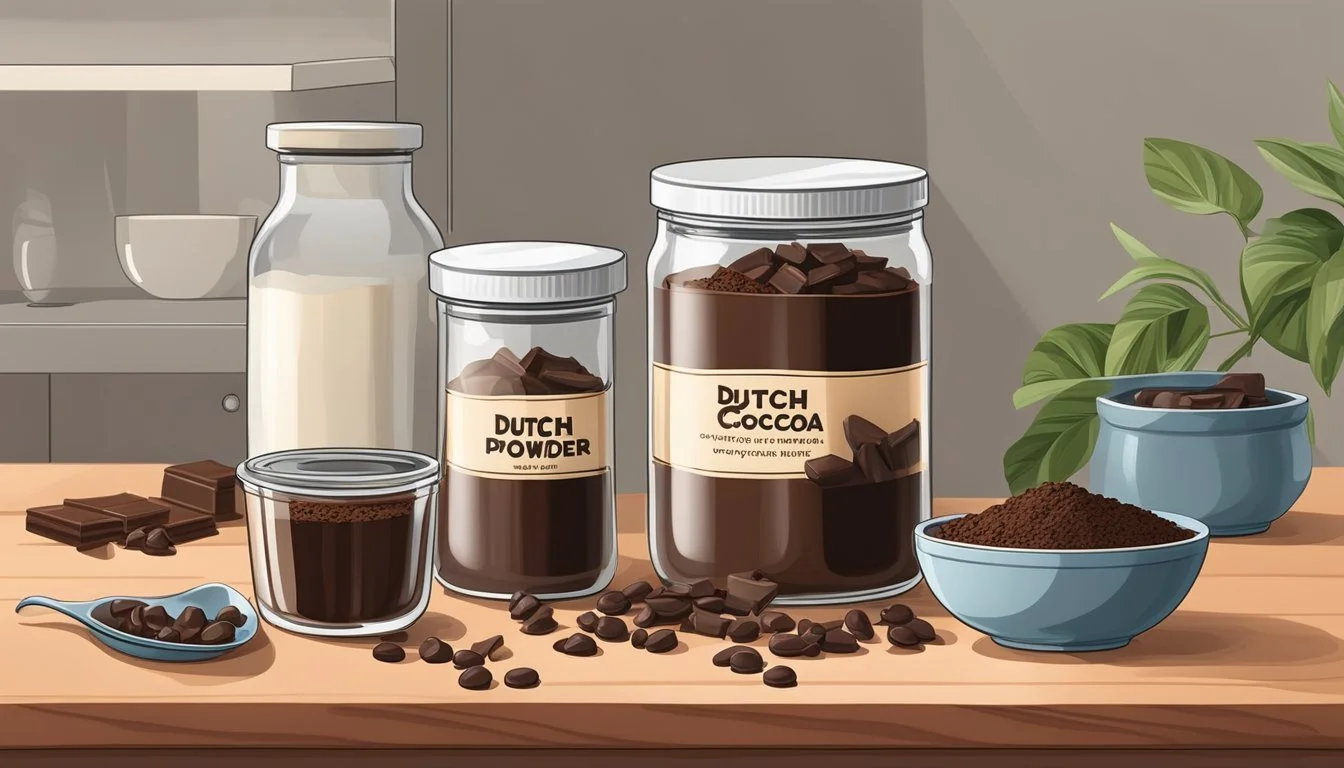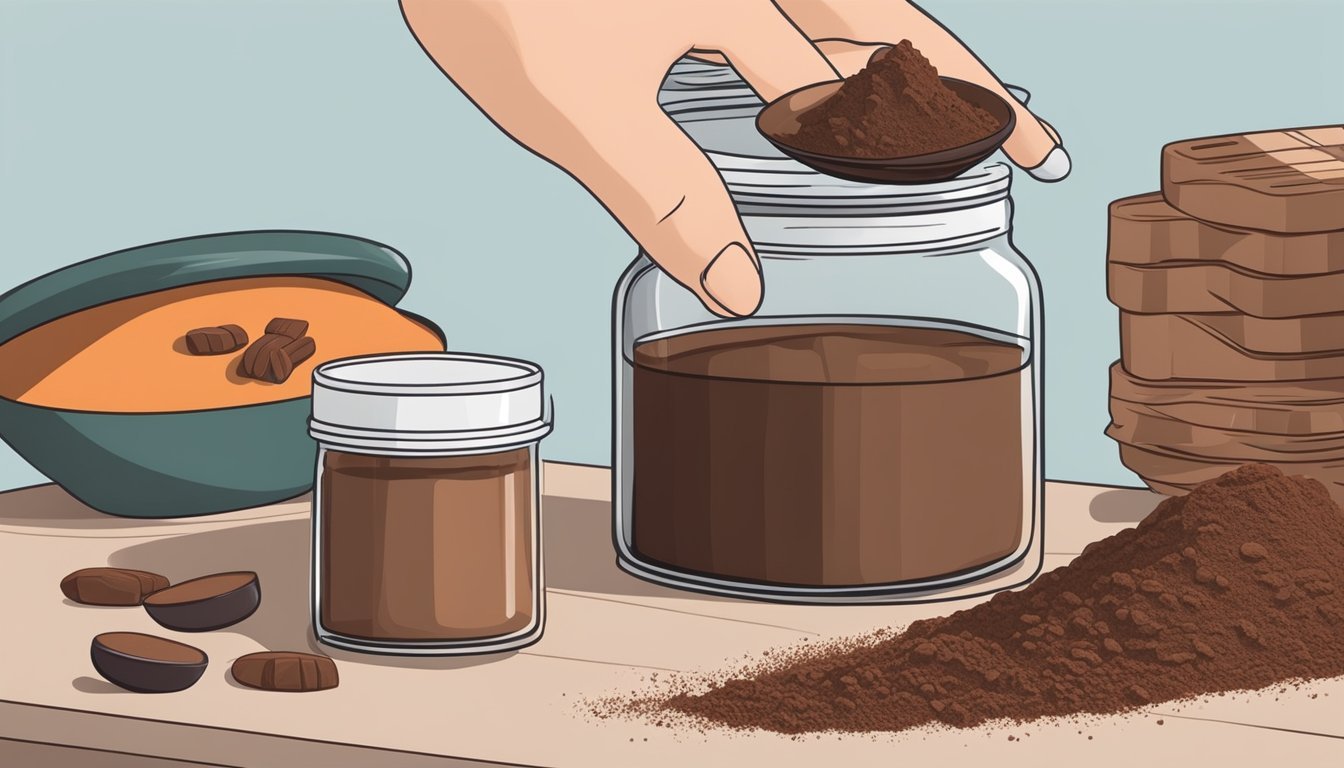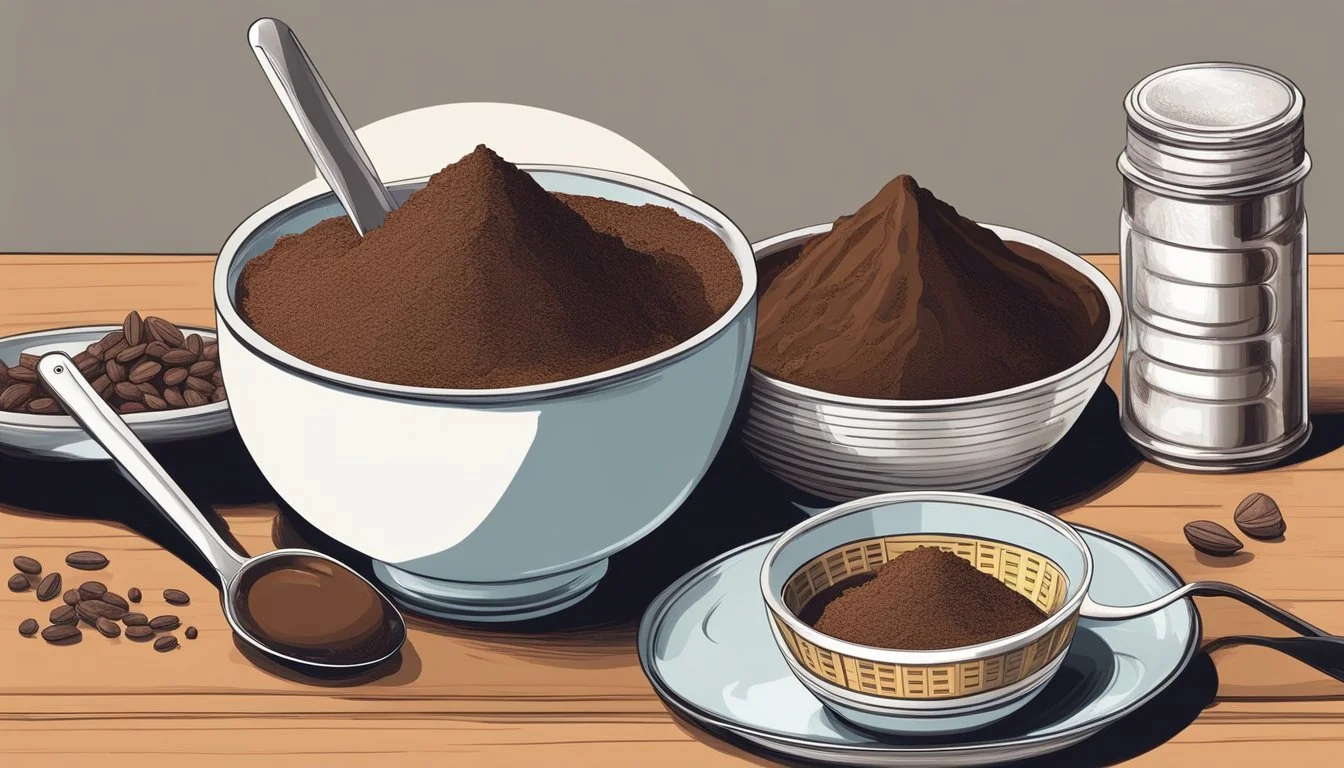Dutch-Process Cocoa Powder Substitutes
Top Alternatives for Baking
When you're in the middle of a baking project and realize you're out of Dutch-process cocoa powder, don't worry; there are several effective substitutes you can use. One reliable substitute is unsweetened baking chocolate. Replace three tablespoons of Dutch-process cocoa powder with one ounce of unsweetened baking chocolate, adding 1/8 teaspoon of baking soda for each three tablespoons to balance the acidity. This alternative maintains the recipe’s structure but be mindful of the additional fat content.
Another versatile option is carob powder. It can be used in equal amounts to Dutch-process cocoa powder and boasts a subtly sweet flavor that works well in various desserts. This makes it a seamless replacement in your recipes and ensures the final product retains a desirable taste and texture.
Natural cocoa powder is also a feasible substitute. Use the same quantity as Dutch-process cocoa and add 1/8 teaspoon of baking soda for every three tablespoons of cocoa powder. This combination helps to neutralize the acidity and provides a similar outcome in your baked goods. These substitutes offer flexibility and ease, making them handy solutions in any kitchen.
Understanding Cocoa Powder
Cocoa powder comes in different types, each with unique properties and uses. The most common ones are natural cocoa powder and Dutch-process cocoa. Knowing their differences and how they are made can enhance your baking and cooking experience.
Types of Cocoa Powder
Cocoa powder is essentially made by grinding cocoa beans and removing the fat or cocoa butter. Two primary types are natural cocoa powder and Dutch-process (alkalized) cocoa powder.
Natural cocoa powder is acidic and has a pH between 5 and 6. It offers a strong, bitter flavor and is often used in recipes requiring baking soda.
Dutch-process cocoa powder is treated with an alkaline solution that neutralizes its acidity, resulting in a smoother, milder flavor. It is less bitter and darker in color compared to natural cocoa powder.
The Dutch-Process Method
The Dutch-process method involves treating cocoa beans with an alkaline solution, specifically potassium carbonate. This process neutralizes the beans' natural acidity and raises the pH to around 7, making the cocoa powder pH neutral.
This alkalization process enhances the cocoa's solubility in liquids, making it perfect for creating smoother hot chocolate, darker cakes, and richer brownies. The method also impacts the color, turning the cocoa powder a deep, dark brown.
Natural vs. Dutch-Processed Cocoa Powder
Natural cocoa powder and Dutch-processed cocoa powder differ mainly in acidity and flavor. Natural cocoa is more acidic and has a stronger chocolate flavor, ideal for recipes requiring baking soda for leavening.
Dutch-processed cocoa, being pH neutral, works well in recipes using baking powder. It produces a milder, smoother taste and a darker appearance, suitable for various desserts and beverages.
In summary, choosing between these two depends on the recipe's requirements and the desired flavor and appearance of the final product. Using the correct type can significantly affect both the chemical reactions during baking and the overall taste and texture of your baked goods.
Why Substitute Dutch-Processed Cocoa?
Dutch-processed cocoa powder may need to be substituted due to availability issues, dietary preferences, or taste preferences. Each of these factors can guide the selection of the most suitable alternative for specific recipes or individual needs.
Availability Concerns
Dutch-processed cocoa powder isn't always available in all grocery stores or regions. Supply chain limitations or regional product selections can make finding this specific type of cocoa powder difficult. When faced with such limitations, alternatives like unsweetened baking chocolate or carob powder can be practical substitutes.
Unsweetened baking chocolate: Use 1 ounce for every 3 tablespoons of Dutch-processed cocoa, adding 1/8 teaspoon of baking soda.
Carob powder: Replace in a 1:1 ratio for a naturally sweet flavor.
These substitutes ensure that recipes remain accessible regardless of the availability of specific ingredients.
Dietary Restrictions
Dietary restrictions often necessitate the search for suitable substitutes for Dutch-processed cocoa powder. For individuals with lactose intolerance, gluten sensitivity, or vegan diets, choosing the right substitute is crucial.
Carob powder: Ideal for those needing a caffeine-free, dairy-free, and gluten-free option.
Natural cocoa powder: Works well for those avoiding processed foods; note that it may affect acidity levels and rise in baked goods.
Unsweetened baking chocolate: Suitable for vegans when using dairy-free options.
Awareness of these dietary concerns ensures that everyone can enjoy their favorite recipes without compromising on their health requirements.
Taste Preferences
Taste preferences also play a significant role in deciding whether to substitute Dutch-processed cocoa powder. Dutch-processed cocoa is known for its mild, less acidic flavor due to the alkalization process it undergoes. However, some individuals might prefer a different taste profile.
Carob powder: Provides a subtly sweet flavor, making it a great alternative for those who find Dutch-processed cocoa too intense.
Natural cocoa powder: Offers a more robust and slightly bitter flavor, suitable for recipes that benefit from a deeper chocolate taste.
Choosing the right substitute can significantly affect the final taste of the recipe, making it more enjoyable for those with specific flavor preferences.
Choosing Substitutes
Selecting the right substitute for Dutch-processed cocoa powder depends on factors like flavor, color, fat content, acidity, and leavening properties.
Factors to Consider in Substitutes
When replacing Dutch-processed cocoa powder, flavor is crucial. Some substitutes, like natural cocoa powder, might have a stronger, more bitter taste. Carob powder offers a subtly sweet flavor, while unsweetened baking chocolate can provide a rich, chocolatey taste.
Color can also vary. Cocoa powders and baking chocolates often maintain the deep brown color, but carob powder might be lighter.
Fat content changes depending on the substitute. Unsweetened baking chocolate has higher fat, needing recipe adjustments.
Acidity and leavening properties play a role in baking. Natural cocoa is more acidic and may require additional baking soda for proper leavening.
Dutch-Processed Cocoa Powder Alternatives
Finding suitable substitutes for Dutch-processed cocoa powder is essential for maintaining the desired flavor and texture in your recipes. Various alternatives can be used, each bringing distinct characteristics to your baking endeavors.
Natural Cocoa Powder
Natural cocoa powder is an excellent alternative. Unlike Dutch-processed cocoa, it is more acidic and has a stronger chocolate flavor. The acidity interacts with baking soda, creating a leavening effect, which can be beneficial in recipes requiring a rise.
When substituting, use a 1:1 ratio. Due to the acidic nature, consider adjusting the leavening agents accordingly. This adjustment ensures the final product maintains its intended texture and consistency. While it lacks the mellowness of Dutch-processed cocoa, it offers a robust chocolate taste.
Unsweetened Baking Chocolate
Unsweetened baking chocolate provides a rich and intense chocolate flavor. Replace 3 tablespoons of Dutch-processed cocoa powder with 1 ounce of unsweetened baking chocolate. Additionally, add 1/8 teaspoon of baking soda for every 3 tablespoons of cocoa powder needed.
This method increases the overall fat content in your recipe. To balance this, omit 1 tablespoon of fat from the recipe for every ounce of chocolate used. This substitute is ideal for baked goods where a deep chocolate flavor is desired.
Chocolate Chips
Chocolate chips, while not a direct substitute, can be used in various applications. Melted chocolate chips can replace cocoa powder in batter or dough. Use a 1:1 ratio by volume, ensuring the melted chocolate is smooth and consistent.
This substitute changes the texture and moisture levels in your recipes. Therefore, reduce other liquid ingredients to achieve the desired consistency. Chocolate chips offer a sweet and creamy texture, making them suitable for cookies and brownies.
Carob Powder
Carob powder is a naturally sweet alternative. It lacks caffeine and the bitterness found in cocoa, making it suitable for those with dietary restrictions. To use carob powder, maintain a 1:1 substitution ratio by volume.
Carob powder imparts a slightly different flavor profile, being sweeter and less intense than cocoa. This can enhance certain recipes, like cakes and breads, where a mild chocolate flavor is preferred. It also does not require additional leavening adjustments.
Cacao Powder
Cacao powder is a minimally processed form of chocolate, rich in antioxidants. It provides a more complex and intense chocolate flavor compared to Dutch-processed cocoa powder. Use a 1:1 ratio when substituting, though it may affect the bitterness of the final product.
It's important to note that cacao powder retains more nutrients due to less processing. This makes it a popular choice for health-conscious bakers. Adjust sweetness levels in your recipes to balance the natural bitterness of cacao.
Substitutes in Recipes
When substituting Dutch-process cocoa powder in recipes, it's crucial to understand the ratios needed, how to account for variations in fat content and acidity, and the impact on flavor.
Substitution Ratios
Different substitutes require specific ratios to achieve the desired results in your recipe. Carob powder can be used in a 1:1 ratio, making it an easy swap. Unsweetened baking chocolate is another option: for every 3 tablespoons of Dutch-process cocoa powder, use 1 ounce of unsweetened baking chocolate combined with 1/8 teaspoon of baking soda.
Other alternatives like natural cocoa powder can be used as-is but may alter the taste and texture slightly. Always ensure to use precise measurements for consistency.
Adjusting for Fat Content and Acidity
Substitutes can have differing fat content and acidity, affecting the final product. Unsweetened baking chocolate adds more fat, so reduce the recipe’s other fat sources by 1 tablespoon for every ounce used.
Carob powder generally has less fat but also lacks acidity. Using natural cocoa powder introduces acidity; thus, replace some baking powder with baking soda to neutralize this effect.
These adjustments are vital, especially in baked goods, to prevent texture issues or imbalanced flavors.
Flavor Considerations in Substitutes
Each substitute brings its unique flavor, making it essential to choose based on the desired taste profile. Carob powder has a naturally sweet and mild flavor, suitable for those avoiding caffeine.
Natural cocoa powder is more bitter and intense, impacting the recipe's sweetness. Unsweetened baking chocolate contributes a rich, deep chocolate flavor but can also intensify bitterness.
Carefully select substitutes based on the recipe type and personal taste, balancing any additional sweetness or bitterness needed to achieve the perfect flavor.
Using Substitutes in Common Desserts
Substituting Dutch-process cocoa powder in desserts can be straightforward if the right alternatives are used. The substitutes you choose can significantly impact the flavor, texture, and appearance of your final product.
Baked Goods and Pastries
Black cocoa powder is an excellent substitute in baked goods like cakes and cookies. It provides a deep, dark color and an intense, rich chocolate flavor without needing to adjust other ingredients in the recipe. When using natural cocoa powder as a substitute, remember to add a small amount of baking soda to neutralize the acidity if the recipe initially called for Dutch-process cocoa.
Using unsweetened baking chocolate instead of Dutch-process cocoa powder in brownies or chocolate cakes also works well. Replace 3 tablespoons of cocoa powder with 1 ounce of unsweetened baking chocolate plus an additional 1/8 teaspoon of baking soda for balance. Even though baking chocolate has a slightly different texture, the flavor remains rich and satisfying.
Hot Cocoa and Drinks
For hot cocoa or drinking chocolate, black cocoa powder can deliver a luxurious, velvety texture and intense chocolatey flavor. If you prefer a more traditional substitute, using natural cocoa powder is effective, though it will yield a slightly different taste and may require additional sugar to manage bitterness.
When making homemade hot cocoa mix, you can use Dutch-process substitutes interchangeably. Adjust the sweetness to taste. If using unsweetened baking chocolate, melt it first to ensure smooth blending with other ingredients. This method can provide a thicker, richer drink similar to European-style hot chocolate.
Ice Cream and Frozen Treats
In ice cream and other frozen desserts, black cocoa powder ensures a deep, chocolatey flavor and elegant dark color. This works particularly well in recipes that do not rely on baking or chemical leavening.
Using cacao powder also provides a robust flavor profile in ice cream recipes. When replacing Dutch-process cocoa powder, natural cocoa powder can be used, but consider adding a small amount of instant espresso powder to enhance the chocolate taste. The creamy, smooth texture of the finished product remains consistent with these substitutions, ensuring a delightful frozen treat.
Conclusion
When seeking substitutes for Dutch-processed cocoa powder, there are several options available that can work well in various recipes.
Natural Cocoa Powder and Baking Soda: Mixing natural cocoa powder with a small amount of baking soda can help mimic the pH balance and flavor profile of Dutch-processed cocoa.
Unsweetened Baking Chocolate: Use 1 ounce of unsweetened baking chocolate plus 1/8 teaspoon of baking soda for every 3 tablespoons of Dutch-processed cocoa powder. Adjust for the additional fat by omitting 1 tablespoon of fat from the recipe.
Black Cocoa Powder: This highly processed cocoa has a deep, dark color and intense flavor. It can replace Dutch-processed cocoa in recipes, though it may alter the final color and taste slightly.
Carob Powder: Made from ground carob pods, carob powder has a naturally sweet flavor. It provides an interesting alternative that works especially well in recipes requiring no additional sugar.
Cocoa Mix: A mix of natural cocoa powder and Dutch cocoa powder can be a transitional substitute, balancing the acidity and flavor.
Each of these substitutes offers unique qualities that can complement a variety of baking applications.





